Your cart is currently empty!
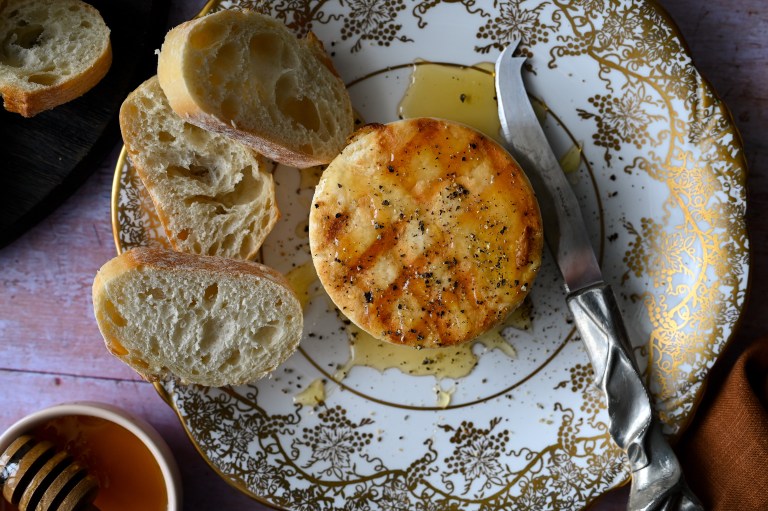
Taking the guesswork out of Greek cooking…one cup at a time
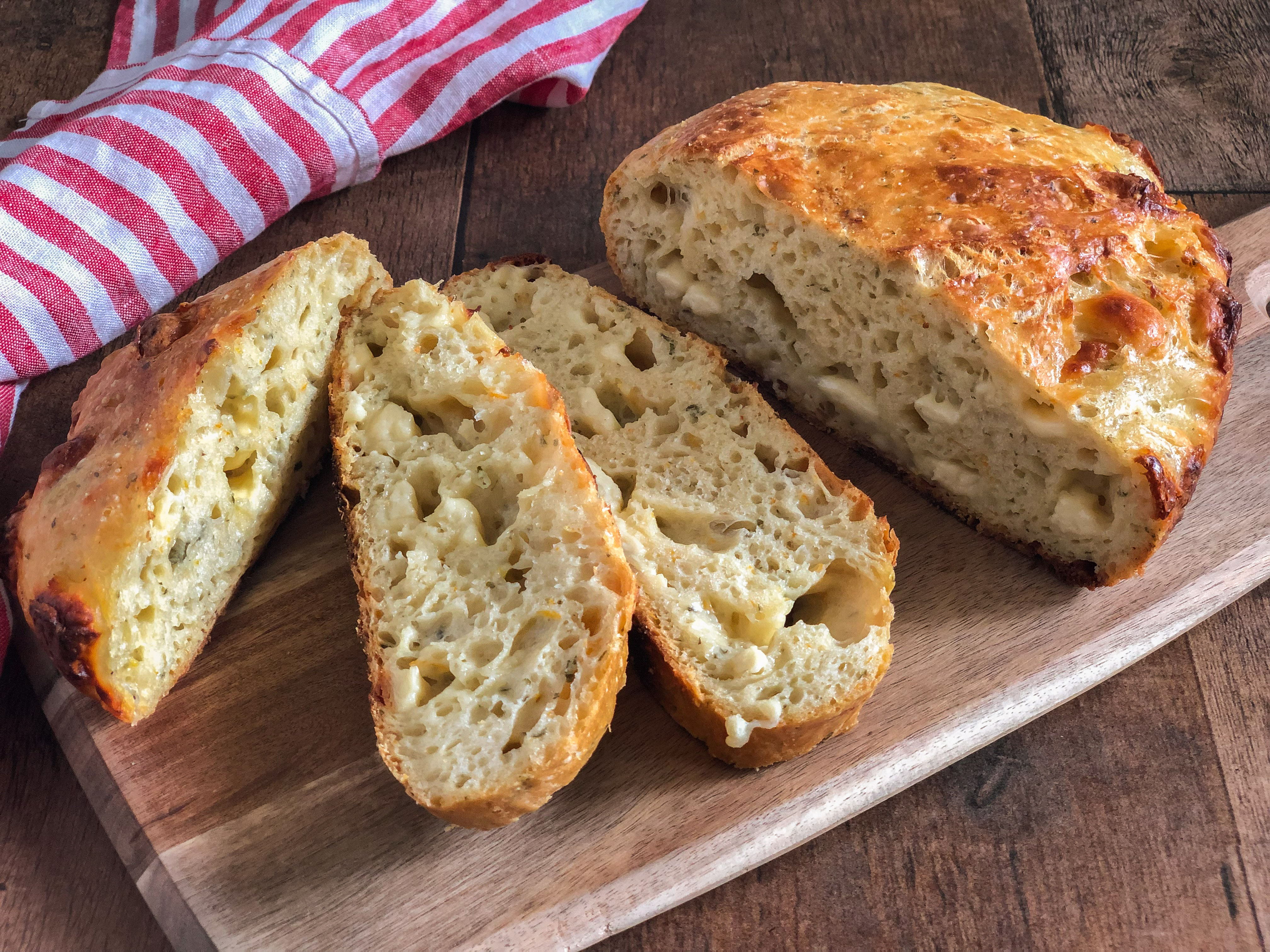
Our no-knead bread with halloumi, mint and orange has a crispy crust and a perfect crumb flavoured with cheese, herbs and citrus
Bread is life. We don’t care how many diets exist which denounce bread as an evil scourge on waistlines, we love it. For us, bread is what makes a meal complete, like when we make green beans with potatoes and use bread to sop up all of the delicious sauces. Or when we finish our horiatiki salad and use bread to soak up the liquid left behind; olive oil, oregano, the juices from the tomatoes and little crumbs of feta. Divine. Life is too short to be denied carbs.
We enjoy making bread almost as much as we enjoy eating it, and there are so many varieties to try. Depending on our mood, and the meal we are planning to serve, we may make kouloures, pita bread, or tiganopsomo with feta. All simple, all delicious, and all quite quick. Other times we are less pressed for bread, and can take our time, and plan ahead. That’s when we turn to our technique, learned from cookbook author and baker Jim Lahey, for no-knead bread. These recipes require some planning as the dough needs at least 14 hours to rise before it can be baked, but is sure is worth the wait. We have already shared with you our recipe for no-knead bread with olives and feta and now we are so excited to share our newest creation. A lovely loaf made with halloumi, mint and orange; a perfect flavour combination combined with a perfect technique. All bread is life, but this bread is living large.

Helpful hints
No-knead breads are very easy to make, but they do require time; minimally about 14 hours of rising for the dough. Remember this when planning your baking.
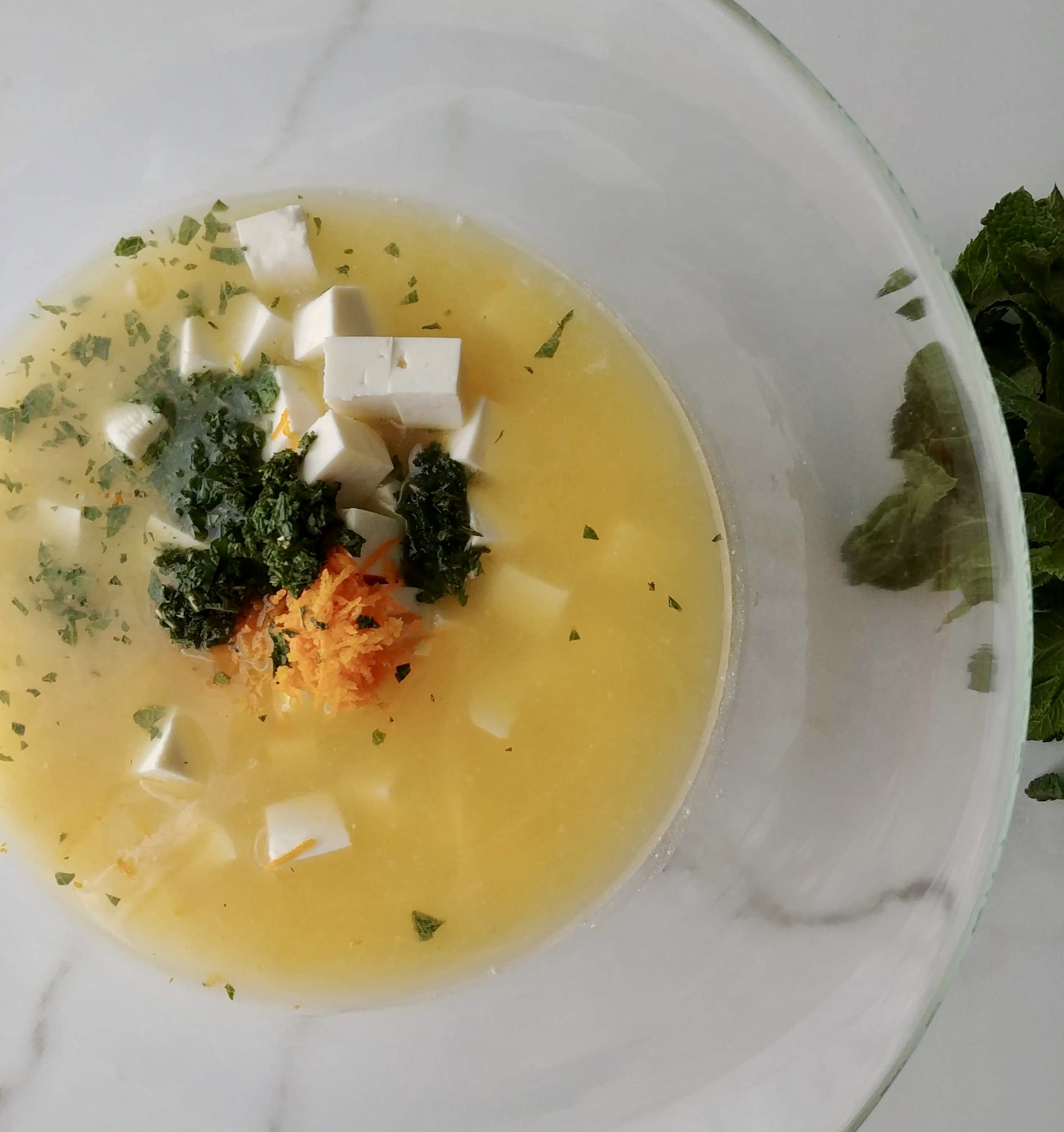
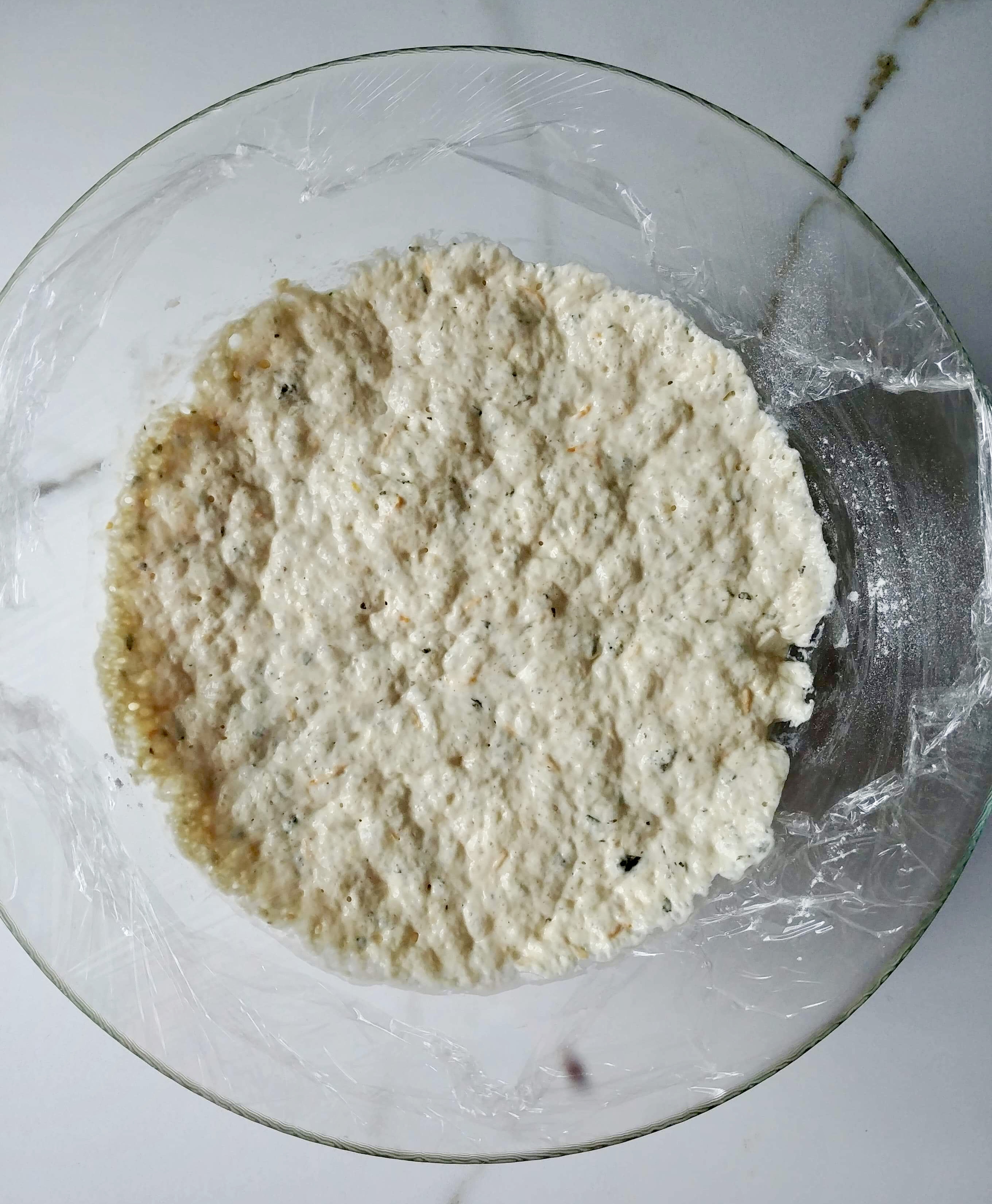
Along with time, you will need a heavy duty pot with a fitted lid. We have made no-knead bread using an enamelled cast iron pot as well as a glazed ceramic one. Unfortunately, despite being of good quality and costing a pretty penny, the latter got damaged. Although the pot is still very usable, it is far less pretty than it used to be. The glaze didn’t seem to withstand the high heat as well as our enamelled cast iron pot does.
Speaking of pots, you want to select a pot which is neither too large nor too small. In fact, if you have a pot which is about the same size as the bowl you have used to allow your dough to rise in, that is ideal. If your pot is too big, your dough will spread out and your bread will be a little flatter than it needs to be.
We like to line the pot with parchment paper when making no-knead bread that contains cheese. This makes clean-up easy and melted cheese less of a problem. But, you have to be super careful not to burn yourself when placing your parchment paper into the pot which has already been heated through (as described in the recipe). We have tried placing the parchment paper into the pot before it first goes in the oven and have found that this causes the parchment paper to burn in places, which then can ruin your bread so we don’t recommend it.

In Jim Lahey’s book My Bread, he suggests using bread flour for his recipes. We used to do that, until one day when we had run out of bread flour and were feeling quite rebellious. Instead of going bread-less, we opted to use all purpose flour (which incidentally, is usually less expensive than bread flour) to make one of his recipes. The result…perfectly fine. So, in the recipe which follows, if you want to use bread flour, go ahead. If all you have is all-purpose flour, go ahead anyways.
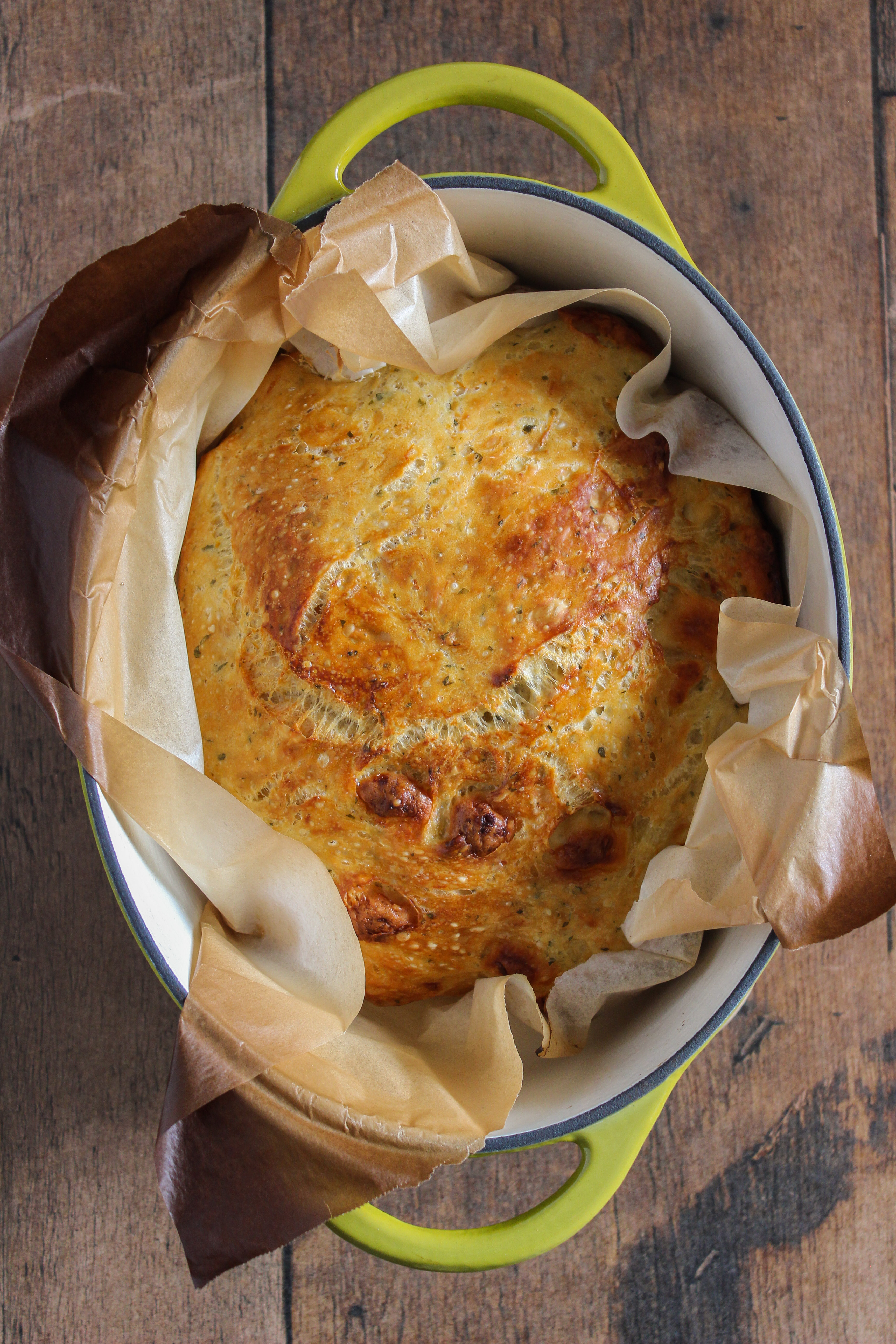
When you remove the no-knead bread with halloumi, mint and orange from the oven and place it on a cooling rack, take a listen. As described by Lahey, you can hear the bread “singing”. It is really a glorious sound, a kind of crackling which occurs when steam escapes from the bread. The sound of delicious things to come.
Once your bread is completely cooled you can wrap it in a clean kitchen towel and then store it in a paper bag. You can also use a plastic bag – just be sure that your bread is not warm at all otherwise the crust will lose it’s crispness in the plastic.
Disclosure: This post contains Amazon affiliate links. If you purchase something through the link, we may receive a commission at no extra charge to you.
Things you might need:

If you’d like to see more delicious breads, see these:
Lagana
Kouloures
No knead bread with olives and feta

I just found your site as I was aching for some Greek veggie dishes. The rare 2+ days of 90 degree weather in San Francisco and an upcoming family gathering with “the Greek side of the family” got me here. Thank you – love the site t
Thank you so much Myrna! Your comment has really made our day. We’re so happy you found us, and enjoy your big, Greek gathering!! We hope you find some recipes to try for your family. 🙂
I made the bread and it’s delicious. I wonder though if I’ve understood the temperature/baking time correctly; heat the pan and lid at 475 for 30 minutes, bake the bread, covered for 30 minutes at 475, then uncovered, still at 475 for 20 minutes? 475 seems to be very high. I was worried about the bread burning so lowered the temperature to 375 and it seemed to work well. Should I have left it at 475 from start to finish?
Hi Marjie! Thank you so much for trying our recipe, and for your comment and question. You did read the recipe correctly; the temperature is to be set to 475 degrees Fahrenheit. This is why it’s important to use a heavy duty pot 🙂 You don’t have to worry about your bread burning if you bake it in the middle rack of your oven. It’s great that your bread turned out even in a lower temperature. We imagine that perhaps the crust was not as “crispy” as if it were cooked in a hotter oven, but maybe not! Thanks for reaching out!
May I ask why the dough needs to be transferred from bowel one to bowel two to rest again for a further 2 hrs ? Can it not just be placed in the preheated pot for cooking after the first rise ? Or left to rise in the cooking pot ?
Hi Chris. You can’t really allow the bread to rise in the cooking pot as you have to preheat the pot (empty) before placing the bread in it to bake. Regarding the need to transfer to another bowl, we think that the action of transferring the dough from one bowl to another makes a difference. Of course, we have no idea if this actually makes any sense! Truth is, the cookbook that this recipe is inspired by, which we refer to in our post, does something similar…so we just did the same thing 🙂
If I wanted to add a cup or so of chopped olives to this recipe, do you know if that would mess up the recipe?
Hi Marko! Adding chopped olives should work out just fine! In fact we have another no-knead bread recipe posted on our site which uses feta and kalamata olives. So good! Enjoy baking your bread 🙂
Hi. I just made this, following the recipe exactly. Unfortunately it has not cooked properly – the crust is good but the inside is still gooey. 🙁
Hi Sophie, That’s unfortunate! We wonder if perhaps you didn’t need to bake the bread longer – ovens do vary and you may find that you need a bit of a longer cooking time for your bread. We suggest that perhaps you try baking the bread without the halloumi to see if that makes a difference and adjust from there. We also wonder if perhaps the cheese was not overly wet when you incorporated it into the dough? Helen & Billie
Hi, thanks for replying. I’ll try again as it tasted good – haven’t wasted it! 😃
Thank goodness for that!! Keep us posted! 🙂
Leave a Reply